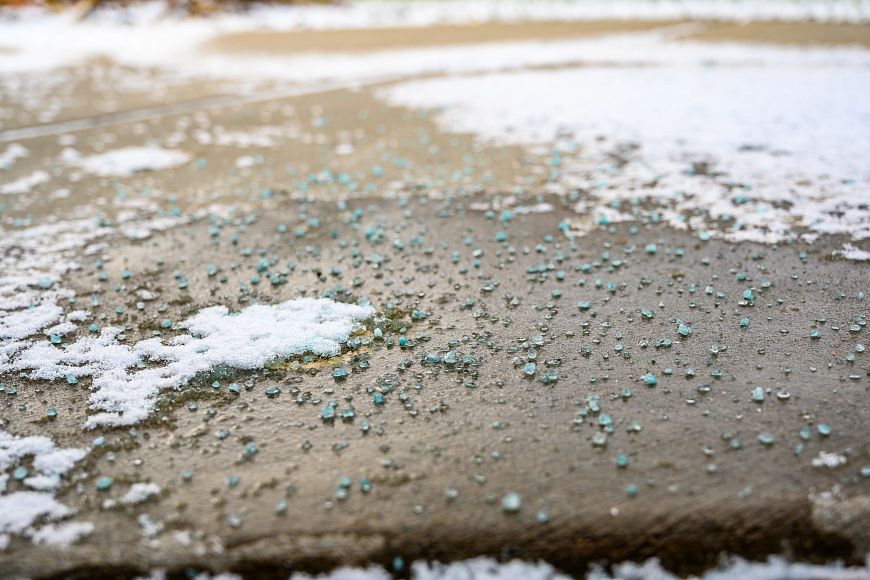Contact: Shannon Haydin, DNR Storm Water Runoff Section Manager
Shannon.Haydin@wisconsin.gov or 608-949-0460
Reduce Salt Use This Winter
Salt Pollution Impacts Fresh Water, Health And Infrastructure
 Over-salting can lead to chloride buildup in lakes, streams and groundwater.
Photo credit: Photo Credit: iStock/Steven White
Over-salting can lead to chloride buildup in lakes, streams and groundwater.
Photo credit: Photo Credit: iStock/Steven White
MADISON, Wis. – The Wisconsin Department of Natural Resources (DNR) and Wisconsin Salt Wise invite the public to learn more about the impacts of road salt on our drinking water and freshwater ecosystems during Winter Salt Awareness Week, Jan. 22-26, 2024.
Winter Salt Awareness Week will include a series of livestreams featuring speakers and topics focused on the actual cost of salt and how to be a freshwater advocate.
Speakers include Hillary Dugan (University of Wisconsin-Madison), Sawyer Bailey (Adirondack Action), Bill Hintz (University of Toledo), Bill Quackenbush (Ho-Chunk Nation), Jeremy Weso (Menominee Nation) and Laura Fey (Western Transportation Institute, Montana State University).
Register in advance or watch afterward on the Wisconsin Salt Wise YouTube Channel.
The Impacts Of Too Much Salt
Although salt keeps Wisconsin roads safe during winter, using more salt than needed comes at a price. In Wisconsin and much of the U.S., chlorides from salt are infiltrating lakes, streams and groundwater. According to Wisconsin Salt Wise, one teaspoon of salt is all it takes to make five gallons of water toxic for freshwater organisms.
The DNR measures chloride levels in Wisconsin rivers over time, monitoring cumulative chloride loading results at 26 of the state’s largest river systems. Recent studies have shown a steep increase in chloride loads. In the early 2000s, the DNR measured about 600,000 tons of chlorides annually. By 2018, that number increased to nearly 800,000 tons per year. Fifty lakes and one stream in Wisconsin have been designated impaired by high salt concentrations.
“All of the 43 long-term trend water quality monitoring sites across Wisconsin are showing increases in chlorides,” said Shannon Haydin, DNR Storm Water Section Manager. “Chlorides persist in the environment forever and cause significant impacts to fish, aquatic life and human health. In Wisconsin, we see evidence of Fresh Water Salinization Syndrome, a condition where our freshwater becomes more like ocean water in terms of saltiness. Now is the time to make a change and reduce salt use when we can.”
These increased chloride loads are partly due to road salting, but chlorides also enter Wisconsin waters because of water softeners and fertilizers. Find out if your softener is salt-wise with this diagnostic tool.
Increased chloride levels, including environmental and economic effects, significantly impact our daily lives. Nationwide, winter salt causes $5 billion in damage to infrastructure each year, causing corrosion on bridges, roads and other infrastructure. Road salt can also impact pets by causing irritated paws or other health concerns if ingested.
Salt Tips For Wisconsin Residents
Reducing salt use is critical to decreasing chloride loads. Follow these steps to right-size your salt use:
- Shovel: Clear walkways and other areas before the snow turns to ice. The more snow removed manually, the less salt you will need and the more effective it will be.
- Scatter: When using salt, scatter it so there is space between the grains. A 12-ounce coffee mug of salt is enough to treat an entire 20-foot driveway or 10 sidewalk squares. If you see oversalting, Wisconsin Salt Wise offers some simple steps to help educate others about salt.
- Switch: Salt is much less effective when pavement temperatures drop below 15 degrees. Switch to sand for traction or a different ice melter that works at lower temperatures.
Statewide Reduction Efforts
The DNR works to reduce chlorides at the source through permitting programs for municipalities and industries. These measures include tuning or replacing water softeners, identifying significant chloride contributors and finding reductions, process efficiencies or improvements by instituting sewer use ordinances.
Additionally, the Wisconsin Department of Transportation works with Wisconsin counties to reduce road salt application using brine and pre-wetting road surfaces, significantly reducing salt use.
For more information on the DNR’s efforts to monitor chlorides and reduce their effects, visit the DNR’s Salt and Storm Water website.

